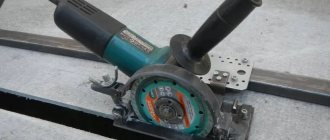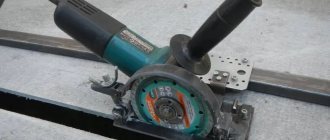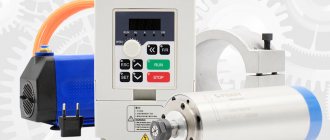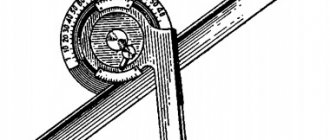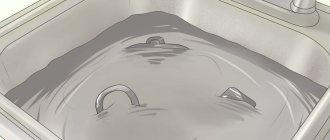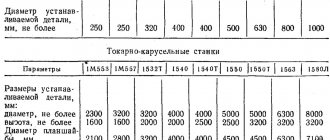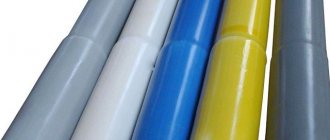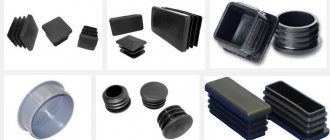Pipes used in water supply and drainage systems, depending on the material of manufacture, are divided into metal (for example, steel, cast iron, etc.) and non-metal (reinforced concrete, ceramic, asbestos-cement, plastic, etc.). The type of pipe material determines their performance characteristics, durability, installation methods and cost. To rationally select pipe materials for water supply and sewerage networks, it is necessary to be guided by specific operating conditions and technical and economic calculations. To ensure the reliability and strength of the pipe material, optimal operating conditions must be determined in terms of pressure, temperature, the nature of the transported medium, as well as the conditions for laying pipelines, the possibility of soil movement, their corrosiveness, the presence of groundwater, etc.
Pipes, connecting parts and fittings must meet the requirements of state standards (GOST), and in cases of difference from them - technical specifications (TU).
Pipelines are a number of interconnected, tightly connected elements:
- pipes of a certain diameter, length, wall thickness, chemical composition of the material and surface quality;
- connecting (shaped) parts;
- fittings used to change and regulate the amount of transported substance;
- structures on the network (for example, manholes on pipeline networks).
Pipelines are classified as pressure and non-pressure. Pressure pipelines transport a substance under a certain pressure (pressure), non-pressure pipelines - by gravity. Pressure pipelines always operate with a full cross-section, while non-pressure pipelines operate with partial filling of the open cross-section of the pipes (0.6-0.9). Pressure pipelines can be laid with any slope, and gravity pipelines can be laid with certain slopes in the direction of movement of the transported substance. The non-pressure mode of water flow with partial filling, typical for the removal of domestic wastewater, has a number of advantages over the pressure mode. When transporting domestic wastewater, a certain reserve is provided in the live section of the pipeline, necessary to pass a flow rate greater than the calculated one, which can be observed within an hour with a maximum flow rate. In addition, the entire branched pipeline system is ventilated through the water-free upper part of the pipe section. At the same time, gases released from the water are continuously removed from the pipelines, which cause corrosion of pipelines and structures on them and complicate the operation of drainage networks. And finally, with a non-pressure mode of fluid movement, the conditions for transporting undissolved impurities with water and the self-cleaning of pipelines from deposits are improved.
In practice, there are also combined pipelines: with gravity and pressure sections. An example would be drainage collectors that cross water channels along their bottoms (siphons).
All pipelines must be constructed in accordance with pre-developed technical documentation and established rules and have proper tightness and reliability. Before putting into operation, pipelines are tested.
The main materials for the manufacture of pressure pipes are steel, cast iron, concrete (reinforced concrete), asbestos cement (chrysotile cement); non-pressure - ceramics, cast iron, asbestos cement, etc. In recent decades, polymer pipes, which have a number of advantages, have been used for the construction and reconstruction of pressure and non-pressure pipelines.
The internal cross-section (diameter) of pipes, connecting parts, fittings and other pipeline elements is measured in millimeters and is called nominal diameter Dy.
The strength of pipes and their connecting parts must correspond to the conditional (nominal) pressure P of the transported medium. Conditional pressure is understood as excess pressure, measured in pascals (Pa) at a temperature of 293 K (20°C), at which long-term operation of pipelines, connecting parts and fittings is ensured. The numerical value of the conditional pressure is indicated in GOST for each type of product.
Typically, the operating (actual) temperature of the transported medium differs from 20°C within significant limits. The highest pressure of the transported medium at the operating temperature at which long-term operation of the fittings and connecting parts is ensured is called the working pressure Pwork.
The density, as well as the strength of pipes, connecting parts and fittings are checked by test pressure Ppr, the value of which is greater than the operating pressure. Tests are carried out with water at a temperature of no less than 278 K (5°C) and no more than 343 K (70°C). The relationships between Ru, Pprab and Rpr for pipes, connecting parts and fittings made of steel, cast iron and bronze are standardized by GOST 356-80. Knowing the operating pressure and temperature, it is possible to determine the conditional and test pressure for the corresponding pipe material.
The main parameters of pipeline operation are hydraulic, thermal and mechanical.
The main hydraulic parameters of pipeline operation include: flow rate (Q), flow velocity (V) and pressure (pressure) (P). The flow rate Q of the transported substance is expressed in units of volume divided by a unit of time (for example, m3/s, m3/h, l/s, etc.), and is measured by special devices - water meters. The speed V of a substance flowing through a pipeline is the distance in meters covered by the substance per second (m/s). The speed (average speed in the pipe cross-section) is equal to the second volume of the product flowing through the pipe (in m3), divided by the cross-sectional area of the pipe (in m2):
V=Q/ω, m/s.
In pressure pipelines, pressure is measured in pascals, but in practice, for convenience, a meter of water column (0.01 MPa = 1 m of water column) or technical atmospheres (pressure in kg/cm2) are often used, 0.1 MPa = 1 atm . Pressure is measured with pressure gauges. Loss of pressure (pressure) is caused by resistance arising from friction of a moving substance against the inner surface of the pipeline. As the speed of movement of the substance increases, the pressure loss increases.
During long-term operation of a pipeline, regardless of the material it is made of, changes in hydraulic parameters may occur due to overgrowth of the internal surface or its corrosion.
Overgrowth of pipelines, in which various types of lumpy deposits form on the inner surface of pipes, fittings and fittings, occurs under the influence of corrosion of the material, accumulation of sand and other random impurities in the bottom part, formation of biofouling on the walls, precipitation of minerals, etc. Corrosion pipeline damage occurs as a result of the influence of the transported product on the pipe walls, as well as the environment. Therefore, it is recommended to select a material for the pipeline on which the transported substance does not have a harmful effect. Maintaining the capacity of existing pipelines required by the project is achieved by periodically cleaning their internal surface using mechanical, hydropneumatic, chemical and other methods and applying protective coatings.
It should be noted that the unevenness of the surface of the internal walls of pipelines is determined by the degree of its roughness, which can be attributed to the most important hydraulic properties of pipeline materials. Roughness is generally assessed as the unevenness of the inner surface of pipes in the form of protrusions, which can be, for example, angular or wavy. The cause of roughness is the degree of processing of the inner surface of pipeline materials (natural roughness) and the appearance over time of various kinds of growths and cavities as a result of the influence of a large number of factors (acquired roughness).
Roughness is measured with a profilometer. The shape and size of corrosion deposits on the inner surface of pipes can be very diverse: drop-shaped; cone-, wave-, cake- and icicle-shaped. The size of corrosion deposits varies widely. Even if we assume that the walls of the pipe are covered with exactly the same roughness elements, then the resistance provided by such a wall to the movement of liquid depends not only on the shape and height of the roughness elements per unit surface, but also on their grouping along the surface of the pipe.
Roughness causes loss of energy (water pressure) during the movement of liquid flow in pipelines, regardless of the material of their manufacture.
To describe the pressure mode of fluid movement, there are concepts of equivalent (or uniformly grained), relative, and for the non-pressure mode - reduced linear roughness.
By equivalent (uniformly grained) (ke, mm) roughness is meant the height of the roughness protrusions, composed of grains of sand of the same size, which, when calculated, gives the same value of the coefficient of hydraulic friction (or resistance along the length of the pipe) λ as the given roughness.
Relative roughness refers to the value ke/d (where d is the internal diameter of the pipeline, mm). The concepts of equivalent and relative roughness mainly relate to the description of pressure regimes of fluid flow in pipelines. The reduced linear roughness refers to the value ε, mm.
The most important characteristic of the flow is the mode of fluid motion (turbulent - vortex with high speeds or laminar - parallel jet with low speeds), which is determined by the dimensionless Reynolds number:
Re=Vl/v,
where V is the characteristic flow velocity, m/s; l is the characteristic transverse linear size of the flow, m; v is the kinematic viscosity coefficient, s/m2.
The viscosity of the liquid depends on the temperature (for example, it is taken equal to V = 1.3·10-6 m2/s at a water temperature of 10°C).
The Reynolds number depends on the roughness of the pipe walls and the shape of the section. Based on experiments in round pipes, the turbulent mode of motion occurs at Re > 2300, and the laminar mode at lower values of the Reynolds number.
Resistance to fluid movement in a turbulent (vortex) flow can be considered in the following main cases: the region of hydraulically smooth pipes, the transition region and the region of rough pipes.
Hydraulically smooth pipes are usually called pipes in which the thickness of the laminar film at the walls completely covers all roughness protrusions.
Hydraulically rough pipes are pipes in which the thickness of the laminar layer is less than the average height of the roughness protrusions.
Smooth pipes have a smooth surface, while rough pipes have a granular, bumpy, pointed (toothed) surface.
For hydraulically smooth pipes, the value of λ is a function of the motion mode criterion Re, and for hydraulically rough pipes it depends on the relative roughness and does not depend on Re.
In the transition region, the value of λ is affected by both the wall roughness and the viscosity of the liquid. In water supply systems, pipes usually operate in the transition region and the quadratic dependence region. Due to its complexity, turbulent flow does not lend itself to theoretical analysis, and therefore the hydraulic calculation of pipes is carried out using empirical formulas.
Thermal parameters of pipelines. These include thermal expansion, i.e. the amount by which the pipeline lengthens when the ambient temperature increases or decreases. This parameter is characterized by the value of the linear expansion coefficient of the material and does not depend on the diameter of the pipes. The coefficient of linear expansion is the amount of elongation when heating a material by 1°C, divided by the length of the sample. Thermal expansion values for some pipes made of different materials are presented in the table below.
Types of pipes for water supply
Plumbing systems are divided into 2 types:
- External water supply;
- Internal plumbing.
The following types of water supply networks are distinguished by purpose:
- Household and drinking water;
- Hot water supply system;
- Fire water supply;
- Recycling water supply;
- Technological water supply networks.
Domestic drinking water supply is often combined with fire water supply. Recycling and technological networks use technical (industrial) water in their work and meet the needs of production processes.
Drinking (cold) and hot water is supplied from centralized networks or from an individual source (well, well). Water heating with an autonomous hot water supply system is carried out in boilers and water heaters.
According to the method of installation, water supply pipelines are divided into 2 types:
- Open gasket;
- Hidden (closed) gasket.
Depending on all these characteristics and technical indicators (working pressure, temperature), pipelines for water supply systems are selected.
Water supply pipelines according to the material of manufacture are divided into 2 large groups:
- Metal;
- Polymer (plastic).
Metal pipes include the following:
- Carbon steel steel;
- Stainless steel;
- Galvanized steel;
- Copper.
Some authors write about cast iron socket pipes for water supply. It should be noted that these pipes are usually used only for sewerage systems (non-pressure).
Polymer plastic pipe systems include the following types of pipelines:
- Metal-plastic;
- Polypropylene;
- Polyethylene;
- Polyvinyl chloride;
- Polybutylene.
Gas
Photo: Depositphotos
The most gas pipelines have been built in the world. The first gas pipeline was built in China about 4,300 years ago. Gas was supplied through bamboo pipes from the field to nearby consumers to produce light and heat and to evaporate salt from the brine solution. Gas flowed through the pipes due to excess pressure in the gas layer underground, so the gas pipeline could not be too long.
Subsequently, long-length gas pipelines from fields to consumers began to be built only in the 20th century.
The first gas pipeline for delivering gas to consumers was built in 1825 in the USA, in the city of Fredonia. And the first main gas pipeline, 195 km long, was also built in the USA in 1891, it ran from gas fields in the north of Indiana to Chicago.
At the beginning of the 20th century, the construction of gas pipelines in the United States continued; in 1928-1932, main gas pipelines were built from the Panhandle field to Chicago (1570 km) and Detroit (1375 km).
A station on a gas pipeline used for loading and unloading control pressure gauges (pigs) of pipelines Photo: ru.wikipedia.org
In Europe, in Poland, the first gas pipeline from the field in Dashawa to Stryi was built in 1924, and was subsequently extended to Lviv.
Since the mid-20th century, the construction of gas transport pipelines has accelerated. In the USSR, gasification of industry and the country also began and large-scale construction of gas transport pipelines from fields to consumers began.
Nowadays, all of Western Europe is gasified, and gasification of Russia continues actively.
Steel water supply pipelines
Steel pipes are universal for cold and hot water supply, heating, and are used for external and internal networks. This is due to the high strength of the material and thermal resistance.
Installation of systems is carried out using welding (electric arc, gas) and threaded connections (coupling). To carry out the work independently, you need welding skills and appropriate equipment; for coupling joints, plumbing skills are required.
It is worth noting that stainless steel is welded with special electrodes, otherwise the welded joint and the material in the joint area become unstable to corrosion.
Galvanized pipes have a zinc coating - internal, external or both.
Such pipelines are connected only by means of couplings; during welding, the protective zinc layer will be destroyed. Moreover, in all cases (black, galvanized or stainless steel) in the thread zone, the thickness of the pipe wall decreases at the turns and this is where the first leaks most often occur.
Carbon steel pipes (seamless, seamless) usually last about 15 – 20 years. This is caused by high corrosive wear of the material.
The inner surface of pipes is prone to the formation of deposits, build-ups, contamination, and scale. This negatively affects the permeability of the working environment and deteriorates the quality of water.
Galvanized pipes last on average up to 30 years (with high-quality galvanizing). Stainless steel pipes will last a long time, more than 50 years, but they are very expensive. In addition, not all stainless steels are approved for use in drinking water networks.
The advantages of steel pipes are:
- Versatility;
- Strength;
- Shaped parts (fittings) have a full bore cross-section similar to the cross-section of a pipe;
- Long service life for stainless and galvanized pipes.
In the last decade, steel pipes have been actively replaced by polymer systems. This is due to the presence of a lot of shortcomings:
- Susceptibility to corrosion;
- Heavy weight, inconvenient installation;
- Short service life (for “black” pipes);
- The need for painting, thermal insulation.
Stainless steel
In recent years, the Russian market has shown steady interest in stainless steel pipelines. They are used mainly, like copper, for piping boiler rooms, and less often in water supply systems. There are two types of stainless steel pipes - corrugated flexible pipe and rigid, straight pipe, supplied in rods. In addition to piping boilers in heating systems, corrugated pipe is also used for gas supply and in water heated floor systems. The method of connecting such pipes is collet; for straight pipes, radial pressing, similar to copper. Such pipes are produced mainly in Germany and Russia. In terms of cost, a corrugated pipeline is significantly cheaper than straight pipes, but it is also less aesthetically pleasing, so it is used more often for hidden wiring.
Copper water pipes
Copper pipelines are rarely used for the installation of water supply systems. Their use is limited to internal hot water supply; they are occasionally used in internal cold water supply systems. This is due to the high cost of the material.
But copper pipes have remarkable properties. They are practically unaffected by external factors - corrosion, aggressive environments, do not form deposits, and are environmentally friendly.
Installation of copper pipelines is carried out in two ways:
- Soldering with special solder;
- Use of compression (threaded) fittings.
Soldering pipes requires skills and equipment. You can do the assembly yourself using compression fittings. Moreover, you should know that copper pipe is divided into 2 types:
- Annealed;
- Unannealed.
When annealed, the annealed pipe acquires flexibility and ductility, which greatly facilitates installation - the pipeline can be bent (within reasonable limits, no more than 60 - 700). Unannealed materials are stronger but have high rigidity.
The advantages of copper pipelines include:
- Long service life (longest among basic materials);
- Neutrality;
- High strength.
The main disadvantages of the copper system are:
- High cost of material;
- Difficulties in self-installation (soldering).
Slurry lines
It is sometimes more profitable to transport ore concentrates or coal from the place of production to the port not in containers, by car or by rail, but in the form of an aqueous suspension through a pipeline. The concentrate is mixed with water and pumped through pipes to where it is needed. After pumping, the concentrate is separated from the water, the water passes through a filter system for purification, and the dried concentrate enters the port.
Sludge from ore washing, 1897. Photo: ru.wikipedia.org
In Ohio, two slurry pipelines were built in late 1950 to transport coal. In Tasmania (Australia), an 80-kilometer slurry pipeline was built in 1967 to transport iron ore.
There are two slurry pipelines in operation in India with a length of more than 250 km.
A 525 km long slurry pipeline is currently being designed in Brazil to transport iron ore concentrate.
Polymer (plastic) pipes for water supply
In recent decades, polymer pipes have become a confident leader among all materials in the construction of water supply systems. This is due to their low cost, long service life, and ease of installation. The main types of polymer pipes are:
- Metal-plastic;
- Polypropylene;
- Polyethylene;
- Polyvinyl chloride (PVC), polybutylene.
Metal-plastic pipes
Metal-plastic pipes consist of 5 layers - the inner one is made of polyethylene, the middle one is made of aluminum, the outer one is made of polyethylene, with 2 layers of adhesive between them. The maximum operating pressure is 10 kgf/cm2, the maximum temperature is up to 950C (short-term - up to 1300C).
The diameter of the pipes is limited to 40 mm (internal - 33). The pipeline has good flexibility, which facilitates installation and reduces the number of connections. Metal-plastic is used mainly for internal plumbing.
Installation of metal-plastic pipes is carried out using brass fittings in two ways:
- Compression (thread clamping);
- Crimping (press).
Both types of fittings have rubber sealing rings on the adapters. Compression fittings are tightened with threaded nuts that compress the brass O-ring. Subsequently, especially when used on hot water, the nuts need to be tightened periodically.
Press fittings are crimped with special pliers (manual or automatic). At the same time, the aluminum sleeve is compressed at the locations of the rubber seals and a tight connection is achieved. Fittings of this type are non-separable and do not require maintenance.
Pipe bending is carried out with a certain radius manually or using a special fixing spring that prevents the pipe from breaking.
Advantages of metal-plastic pipes:
- No corrosive wear;
- Neutrality;
- Strength, with good flexibility;
- Easy installation;
- Long service life - up to 25 years.
There are also a number of the following disadvantages:
- Fittings have a reduced flow area;
- Fittings are expensive;
- No possibility of hidden installation;
- The negative impact of ultraviolet radiation on the outer layer of the product.
Polypropylene pipes for water supply
Polypropylene pipes are classified according to pressure and temperature:
- PN10, working environment temperature up to 450C;
- PN16, working environment temperature up to 600C;
- PN20, working environment temperature up to 950C;
- PN25 (reinforced, stabilized), working environment temperature up to 1000C.
The service life of products varies from 10 to 50 years, depending on the operating temperature. The higher the temperature, the shorter the service life. Pipes with pressure from 10 to 20 kgf/cm2 are used for cold water systems, for hot water - only PN25. The pipes are stabilized (strengthened) by a layer of aluminum or fiberglass.
Polypropylene has all the advantages of polymer systems - lightness, neutrality, resistance to blockages and corrosion.
Polypropylene pipes do not have ductility and flexibility, so they are installed in compliance with the angles and the use of welding full bore fittings (tees, corners, couplings, adapters). Welding (soldering) of materials is carried out with a special welding machine, thereby forming a homogeneous (non-separable) homogeneous connection.
Polypropylene pipes can be laid in any way; most often they are used for internal wiring, less often - for installation of external networks.
Polyethylene pipes
For the installation of external networks, polyethylene pipelines are the most popular. They come in two types:
- Low-pressure polyethylene;
- Cross-linked polyethylene.
Low-density polyethylene (HDPE) is used for transporting cold water with a temperature of no more than 400C, pressure up to 40 - 50 kgf/cm2. The material does not corrode, is neutral and environmentally friendly, does not form blockages. Its main disadvantage is the maximum temperature limitation. In addition, HDPE has a negative attitude towards ultraviolet radiation.
HDPE pipes are installed using compression fittings or welding using special equipment. Welding is carried out for large (more than 63 mm) pipe diameters.
For hot water supply systems, cross-linked polyethylene is used - during its production, additional bonds are formed between molecules (cross-linking). This material has increased strength and thermal resistance. The system is installed using compression and press fittings, and due to the properties of polyethylene, rubber seals are not installed on the press fittings.
Polyethylene pipes have a certain flexibility, but have the highest thermal elongation among all polymers. In this regard, it is not recommended to secure pipelines rigidly. Polyethylene pipes are used for internal and external water supply networks, laid in open and hidden methods (except for cases of using compression fittings).
Polyvinyl chloride (PVC) pipes
PVC pipes are used somewhat less frequently than the materials described above. This is caused by the maximum temperature limitation (650C for a short time).
Polyvinyl chloride pipelines are not flexible and are installed by gluing. The surface of the pipe and fitting are pre-treated with a specialized compound, which cleans and slightly softens the surface of the future joint. After this, the joint is lubricated with glue, the pipe is inserted into the fitting and turned ¼ turn to distribute the glue evenly.
The finished connection is allowed to harden; the duration of curing depends on the diameter of the pipeline.
Pipelines for cold and hot water supply systems should be selected taking into account the following criteria:
- Working pressure and water temperature;
- Laying method;
- Duration of service;
- If necessary, the possibility of self-installation;
- Price.
(507, 1 today)
Beer
In 2016, the world's first beer pipeline was built in the Belgian city of Bruges. The pipe is 3 km long. The pipe is underground and pumps 4,000 liters of beer per hour. The beer is pumped from the De Halve Maan brewery, located in the center of Bruges, to the outskirts of the city, to the industrial area, where further processing of the product takes place.
The beer pipeline brought huge profits to the brewery, because now there is no need to transport large volumes of beer through the very narrow streets of the ancient city. Now the brewery only brews beer, and the filling of bottles and kegs takes place in an industrial area on the outskirts.
Pad
Trunk pipelines are assembled through plateaus, forests, mountainous, swampy areas, highways and other natural and artificial obstacles. The gasket is:
- Ground - pipes are installed on supports that fix them in the design position and protect the structure from sagging and seasonal erosion of the soil.
- Underground - pipes are placed in the soil, in pre-dug trenches. Where it is necessary to bypass obstacles, sections of the line are raised on supports or carried through tunnels. To prevent rusting, the fittings are protected with insulation.
- Underwater (river, sea, swamp) - installed below the surface of the water as sections of the main lines or the entire highway. Gas and oil pipelines are laid on the seabed.
The line arrangement method is selected based on:
- purpose of the system;
- structures along the route;
- types of soils;
- construction budget;
- cost of service.
Main oil and gas pipelines with high pressure are laid only underground. Communications should not pass through populated areas, road and railway bridges, crossings, or seaports. Electrical networks for servicing pipeline equipment are also not built near such systems.
Brine
In Austria, in the village of Hallstatt, salt has been mined for many centuries. To transport the extracted product, a salt pipeline was built in 1595. 13,000 tree trunks were hollowed out and brine was pumped through the resulting pipe from Hallstatt to Ebensee over a distance of 40 km.
I have come across information before that there are pipelines through which sunflower oil and something else are pumped. But now I have not been able to find confirmation. I wouldn’t be surprised at the existence of some even more exotic pipelines!
Tags: modes of transport, pipeline, water supply, water supply and sewerage
